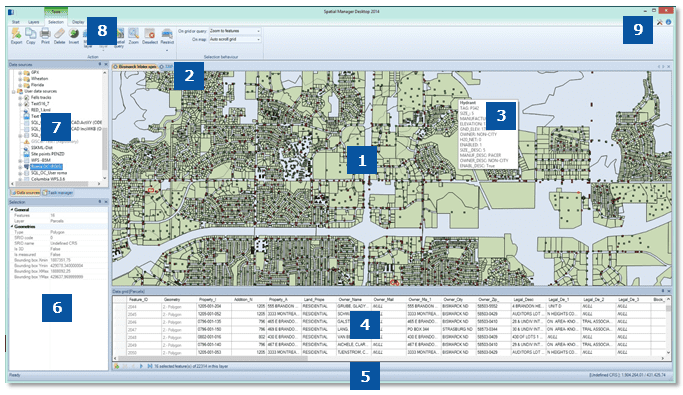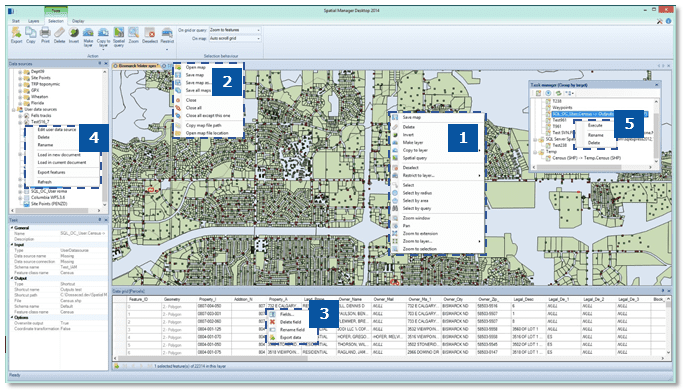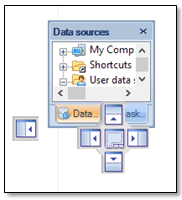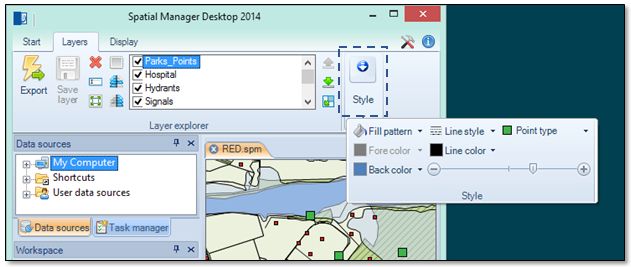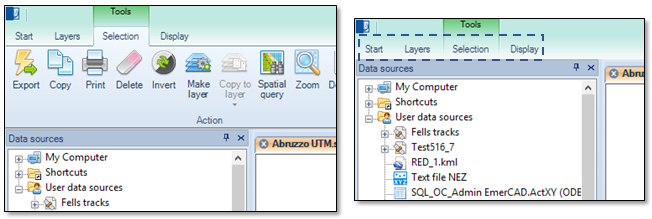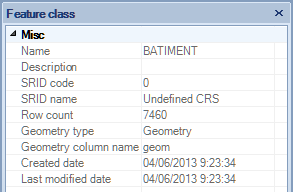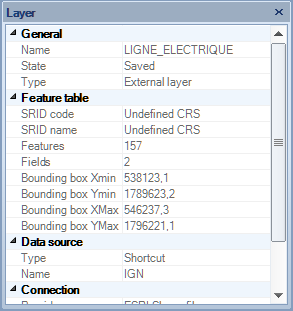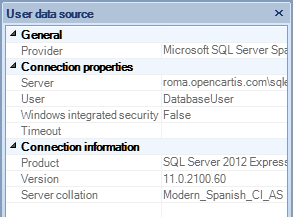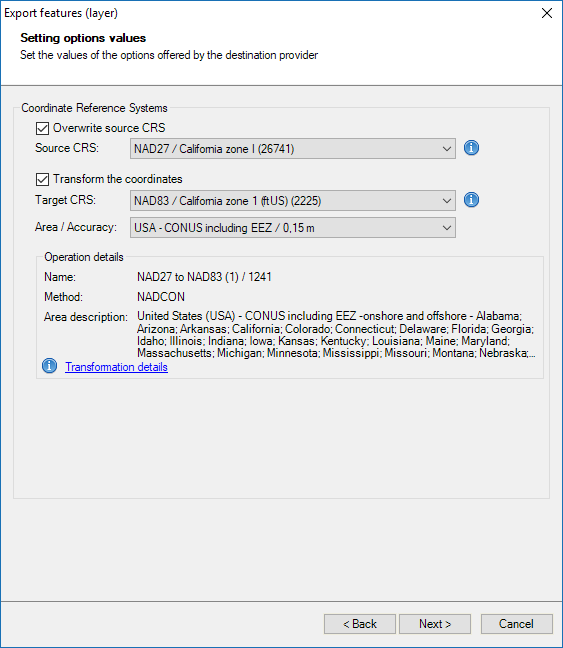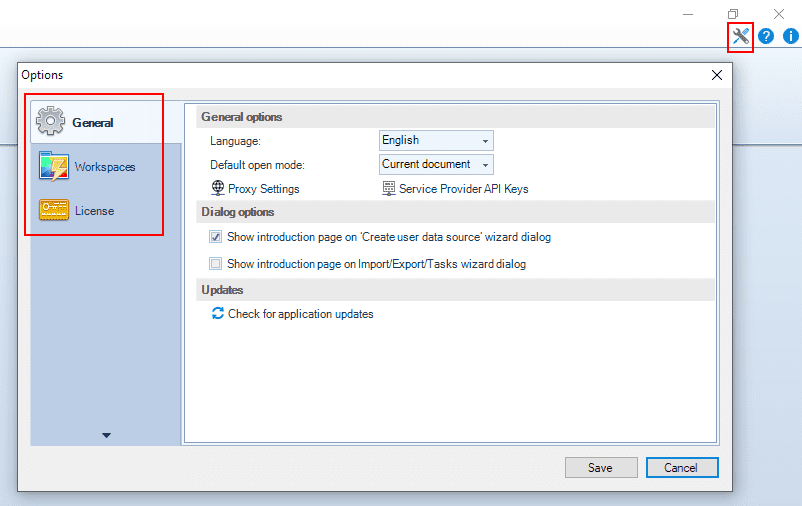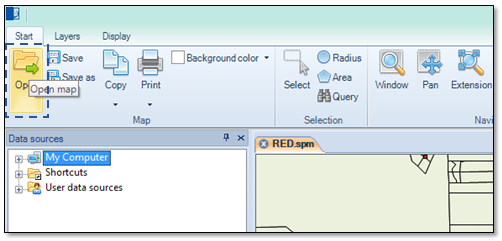Spatial Manager Desktop™ - FAQs: Interface
Default layout
1.Maps workspaces
2.Workspaces tabs. Workspace navigation tools on the right side
3.Data tooltip of the feature under the cursor
4.Data grid panel. Navigation, information and other tools on the bottom
5.Status and information line
6.Properties panel. Content varies depending on the active focus (map, source, task - "Professional" edition only - , etc.)
7.Data sources and task manager ("Professional" edition only) panels (grouped in this picture)
8.Ribbon. Permanent and contextual tabs
9.Other tools (options and preferences, release information, etc.)
1.Workspace
2.Workspaces tabs
3.Data grid panel
4.Data sources panel. Content varies depending on the selected data source
5.Task manager panel ("Professional" edition only)
Application panels
The different panels of the application (Data grid, Properties, Data sources and Task manager - "Professional" edition only) can be arranged, docked, undocked, grouped, self-collapsed, etc., and resized, depending on the preferences and needs of each user or each job, by dragging its title bar, using the absolute or relative position arrows, double-clicking on its title bar, etc.
These panels can also be closed. To reopen a closed panel, use the "Display" tab on the ribbon.
To quickly restore the default panel layout of the application, use the "Restore position" function from the "Display" tab on the ribbon (the application must be restarted).
Ribbon
The functions available through the Ribbon are separated into tabs containing functional groups. These tabs can be static ("Start", "Layers", etc.) or contextual, which are only available under some conditions; for example the "Selection \ Tools" tab, when there are selected items.
Different groups in a tab can be found under its normal display (expanded, all icons and functions of the group are visible on the screen) or compressed (a single symbol appears to dropdown the group), depending on the size of the application window and the space available for the components of the ribbon. The expansion or compression of the groups is fully automatic when the application window is resized.
The ribbon can be set as self-retractable by double-clicking over any of the tabs titles, to expand the space of the application window dedicated to workspaces or the application panels; in this mode, selecting the title of a tab will expand it to show all functions in the tab and will automatically retract it when you select a function. To expand them back again, just double-click over these same tab titles.
Properties panel
When the Properties panel is open, you will see all information about items such as Data Sources, Data Tables, Layers, Maps, etc., depending on the current focus of the application. The next images show you some samples of the Properties panel in Spatial Manager Desktop™
In the Properties panel, by placing the cursor over any data, if CTRL + C (standard combination for “Copy”) is pressed, the corresponding data goes to the Windows clipboard and can be exploited within the same application, or any other, using “Paste” or by pressing CTRL + V
If any data is not fully visible due to the width of the Properties Panel, a Tooltip will display by keeping the cursor over this data
You can edit here the field values of the Feature Classes, as well as you can do in the "Data grid" panel
Wizards
The Wizards are the interface layout chosen for the main Spatial Manager Desktop™ functions ("Create User Data Source" - "Standard" and "Professional" editions only - and "Export/Import/Create task"). Using them you can go forward and backward through the options or parameters needed to complete a function or process
Spatial Manager Desktop™ "Create User Data Source" Wizard
Selecting a data Provider in the "Create User Data Source" Wizard ("Standard" and "Professional" editions only)
Setting up some options (coordinate transformation parameters) in the "Export features (table)" Wizard
Options
You can change the options and the user preferences of Spatial Manager Desktop™ through the "Options" window. This window includes three tabs ("General", "Workspaces" and "License"), to access the options or preferences of the application and also setup shortcuts
- General
- General options
- Language: you can select the interface language for the application
- Default open mode: you can select if an upcoming table from a data source will be open in the current document or in a new document, when double-clicking on the table in the Data sources panel
- Dialog options
- Show introduction page on 'Create user data source' wizard dialog ("Standard" and "Professional" editions only)
- Show introduction page on Import/Export/Tasks wizard dialog
- Updates
- Check for application updates: although by default the application will check for updates automatically, you can click here to check for new application updates whenever you want
- General options
- Workspaces
- Rendering options (see "Maps, layers, views")
- Selection behavior (see "Selecting and filtering")
- License (see "Licenses")
Configuration files
All the settings for Spatial Manager Desktop™ are stored in XML files. This is the list of configuration files:
- Shortcuts.config: Shortcuts configuration
- Tasks.config: Tasks configuration ("Professional" edition only)
- UserDataSources.config: User Data Source (UDS) configuration ("Standard" and "Professional" editions only)
- UserSettings.config: global application settings
You will find them in the folder “user folder\AppData\Local\OpenCartis\Spatial Manager Desktop”
When a file is modified, an automatic backup copy of the file is stored in the sub-folder “backup” within the folder listed above. A backup file includes in its name the date and the time at which it is generated. If you want to restore any backup file, just rename it as the original configuration file and copy it to the appropriate folder, replacing the current application configuration file. You should carry out this operation after closing the application and we recommend you make a copy of the replaced file before replacing it
First steps
Before start working, you should quickly review the components of the user interface of the application, detailed earlier in this article. To do so, follow these steps:
Installing and notes:
- If you do not yet have Spatial Manager Desktop™ installed on your computer, you can purchase the application or download your trial copy through http://www.spatialmanager.com. Check the minimum requirements for the application, select the appropriate version for your operating system (32 or 64 bit) and install it following the instructions in the installation program.
- Download the ZIP file, including some sample files, through the following link: Spatial Manager Desktop Tutorial Samples
- You can also find a small set of sample files, which you can use for your own tests, located inside the folder "Samples" (a subfolder of your application main installation folder)
- Create a new folder on your "C:" drive called "SPM Tutorial" and unzip the contents of the ZIP file you have downloaded, including all the folders, to "C:\SPM Tutorial\".
- Start the application and then open the map "RED.spm", included in the folder "C:\SPM Tutorial\Maps", using the "Open" button on the "Start" tab of the ribbon
- Note 1: when opening the map, you will see the evolution of the different map layers loading on the left side of the status line
- Note 2: "spm" is the extension for Spatial Manager Desktop™ map files
- Feel free to try out the components of the interface:
- Move, dock and undock, group and ungroup or resize the panels of the application by dragging its title bar, using the absolute or relative position arrows, by double-clicking on its title bar, etc.
- Note 3: reminder - use the "Restore position" function from the "Display" tab on the ribbon (the application must be restarted) to quickly restore the default panels layout of the application.
- Move the cursor over the map checking the tooltips of the features included in the layers of the map
- In the "Layers" tab on the ribbon, turn the layers off and on again or choose the selected layer (checking its effect on the Data grid)
- Select features in the map or in the Data grid panel checking the different effects over these components
- Review the contextual menus in the different components of the application
- Check the Properties panel content when changing the focus on the application (workspace, selected features, selected layer, etc.)
- Move, dock and undock, group and ungroup or resize the panels of the application by dragging its title bar, using the absolute or relative position arrows, by double-clicking on its title bar, etc.
Related links
- How to Copy and re-use data from the Properties Panel
- Properties: how to change the focus
- Applications configuration files and backup copy
